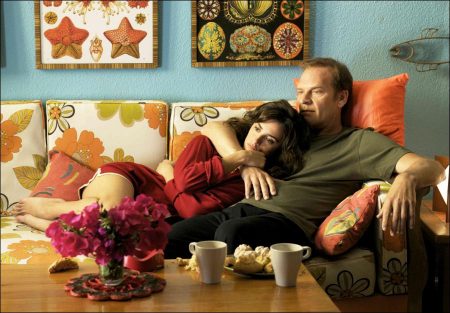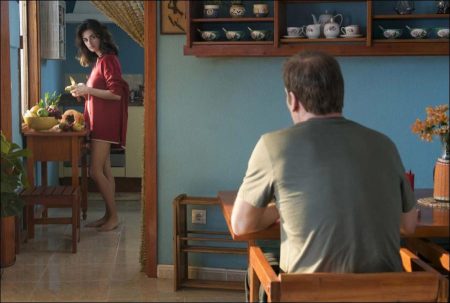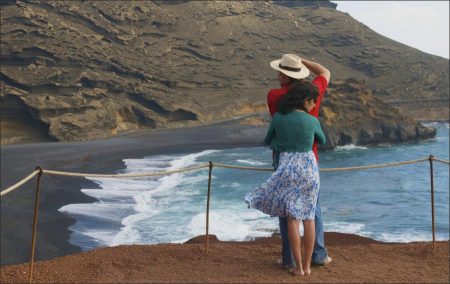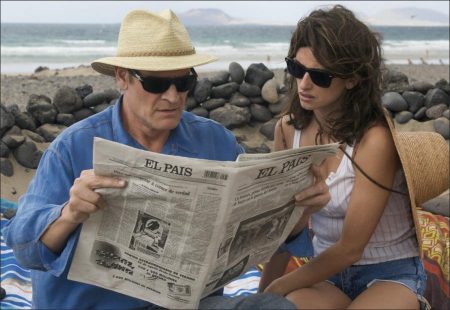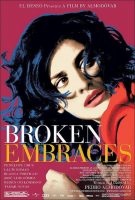Broken Embraces movie storyline. A man writes, lives and loves in darkness. Fourteen years before, he was in a brutal car crash on the island of Lanzarote. In the accident, he didn’t lose only his sight, he also lost Lena, the love of his life. This man uses two names: Harry Caine, a playful pseudonym with which he signs his literary works, stories and scripts, and Mateo Blanco, his real name, with which he lives and signs the film he directs. After the accident, Mateo Blanco reduces himself to his pseudonym, Harry Caine. If he can’t direct films he can only survive with the idea that Mateo Blanco died on Lanzarote with his beloved Lena.
In the present day, Harry Caine lives thanks to the scripts he writes and to the help he gets from his faithful former production manager, Judit García, and from Diego, her son, his secretary, typist and guide. Since he decided to live and tell stories, Harry is an active, attractive blind man who has developed all his other senses in order to enjoy life, on a basis of irony and self-induced amnesia. He has erased from his biography any trace of his first identity, Mateo Blanco.
One night Diego has an accident and Harry takes care of him (his mother, Judit, is out of Madrid and they decide not to tell her anything so as not to alarm her). During the first nights of his convalescence, Diego asks him about the time when he answered to the name of Mateo Blanco, after a moment of astonishment Harry can’t refuse and he tells Diego what happened fourteen years before with the idea of entertaining him, just as a father tells his little child a story so that he’ll fall asleep.
The Title
The two protagonists, who have taken refuge in a bungalow at Famara Beach, on a mountainside facing the beach, are lying in each other’s arms on a couch. They are watching, on a little television set, “Viaggio in Italia” by Rossellini.
The film tells of the collapse of an American marriage -the couple are played by Ingrid Bergman and George Sanders- during a trip to placecountry-regionItaly. On the television we see the sequence in which Ingrid Bergman and George Sanders visit some excavations in Pompeii just when the workers are carefully digging up the remains of the ancient city, destroyed by the eruption of Vesuvius two thousand years before.
Sanders and Bergman witness how the men who are excavating there find the bodies of a man and a woman together (“perhaps husband and wife”, says the archaeologist), whom the lava immortalized while they were sleeping. The image is a shock for Ingrid Bergman who walks off a few feet, shaken by the emotion. The immortalized love of the couple from thousands of years before makes her think of the deterioration and pettiness of her own marriage. And she can’t hold back her tears.
It’s a simple scene, not at all rhetorical, direct and deeply moving. After seeing it on the television, Lena (Penélope Cruz) hides her face on the chest of her lover (Lluìs Homar), as moved as Ingrid Bergman although, unlike her, Lena is being firmly embraced by the person she loves.
She thinks she’d like to die like that, wrapped in an eternal embrace with Mateo. He guesses Lena’s fervent desire. He gets up from the couch, sets up his camera and puts it on automatic. He goes back beside Lena, embraces her tightly, the two look at the camera until the flash immortalizes their embrace like the lava from the volcano in Rossellini’s film. But unlike what happens in the Italian film this won’t be an eternal embrace. Weeks later someone will tear up that photo and many others.
The Credits
The credits appear superimposed on a strange texture, very different from that of the rest of the film. It’s a texture that’s hard to identify. The images, stolen, show a couple in front of the camera, around them a group of men enter and leave the frame. The couple are silent, she facing the camera, he with his back to it, barely looking at each other.
These images were filmed, unknown to the protagonists, by the video camera that is linked up to the Panavision camera with which the film was shot.
This is a control camera to see the takes during and immediately after shooting them. Its images aren’t printed, but that’s what I did and the result is the strange texture that acts as background to the opening credits.
In these images the silent couple leave their positions in front of the camera and are replaced by Penélope Cruz and Lluís Homar. The man and the woman at the beginning are the lighting doubles for Penélope and Lluís.
Penélope looks strangely serious, she’s concentrating, impervious to what’s happening around her. In the next scene she’ll have to cry and I guess she’s getting in touch with her personal store of grief. Although her hairstyle is inspired by that of Audrey Hepburn in “Sabrina”, her attitude reminds me of the replicant (Sean Young) in “Blade Runner”. We can hardly see Lluís Homar’s face, he has his back to us, motionless, looking at Penélope. They seem like two strangers.
The director of photography blocks the camera lens with his head, creating a spontaneous fade to black. This is a film in which the fades to black are very significant. I chose these images to begin the film because they are stolen and furtive images that establish cinema as the territory where most of the action will take place. Also because I’m fascinated by the casual scenes that occur in front of the camera in those moments when no one is shooting. I often stand spellbound looking at them, for me they are a real show.
Shoots today (and life as well) are full of different sized screens which reflect the film and its surroundings… I’m fascinated by all the surfaces that reflect the film. Reflections add a ghostly, mysterious quality to the reflected image.
Continue Reading and View the Theatrical Trailer
Broken Embraces (2009)
Los Abrazos Rotos
Directed by: Pedro Almodovar
Starring: Penelope Cruz, Lluís Homar, Blanca Portillo, Jose Luis Gomez, Ruben Ochandiano, Ángela Molina, Chus Lampreave, Kiti Mánver, Lola Dueñas, Mariola Fuentes, Carmen Machi, Kira Miró
Screenplay by: Esther Garcia, Agustin Almodovar
Production Design by: Antxón Gómez, Víctor Molero
Cinematography by: Rodrigo Prieto
Film Editing by: José Salcedo
Costume Design by: Sonia Grande
Set Decoration by: Marta Blasco, Pilar Revuelta
Art Direction by: Víctor Molero
Music by: Alberto Iglesias
MPAA Rating: R for sexual content, language and some drug material.
Distributed by: Sony Pictures Classics
Release Date: November 20, 2009
Views: 177
